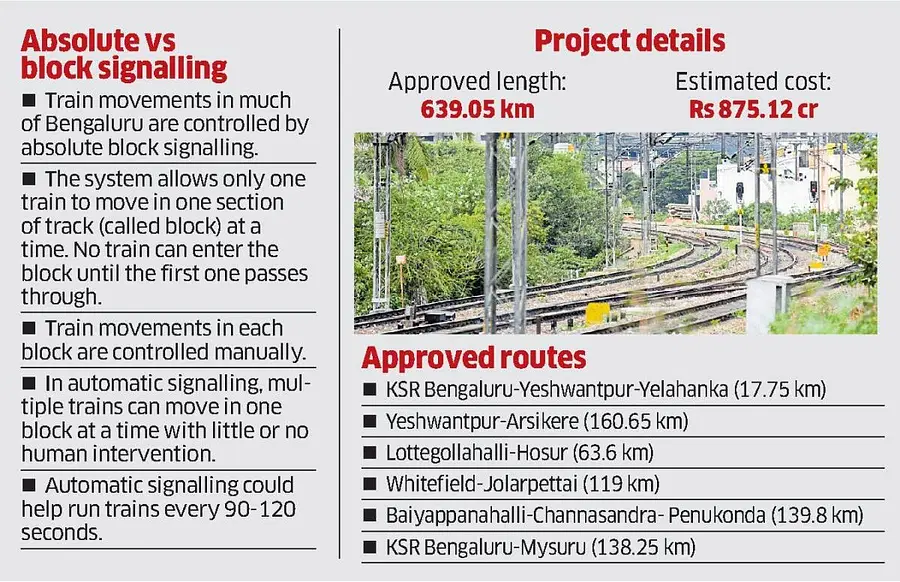Source:https://www.deccanherald.com/india/karnataka/bengaluru/bengaluru-to-get-automatic-signalling-by-2028-trains-could-run-every-90-120-seconds-2968257
Publisher: Deccan Herald
Bengaluru is finally overhauling a key component of its railway infrastructure that could significantly boost line capacity, run more trains at shorter intervals and increase the speed of trains. By 2028, most of the railway network in and around the city is expected to run under automatic signalling.
Widely considered a laggard in railway infrastructure, Bengaluru is set to adopt automatic signalling that could make the sight of slow-moving trains within the city a thing of the past.
Presently, train movements in much of Bengaluru (and Karnataka) are controlled by the absolute block signalling system, which allows only one train to move in one section of track (or block) at a time. No train can enter the block until the first one passes through. Each block covers the distance between two signals or stations, is several kilometres long and controlled manually.
This often results in train delays within Bengaluru.

In contrast, automatic signalling allows multiple trains to move in one block at a time. The train movements are controlled by signals, which work automatically as the train passes past them. There is little to no human intervention.
Mumbai, Chennai and all other large cities known for their robust railway infrastructure adopted automatic signalling long ago. But in India’s IT Capital, where the railway network runs into hundreds of kilometres, only one section (KSR Bengaluru-Bengaluru Cantonment-Whitefield; 23.15 km) has automatic signalling. But this is set to change in the next few years.
The Railway Board last year approved a Rs 874-crore project to introduce automatic signalling in and around Bengaluru. The project will cover five routes spanning 639.05 km (see the table).
The South Western Railway (SWR) has set the ball rolling to introduce automatic signalling in the KSR Bengaluru-Yeshwantpur-Yelahanka section and floated tenders. For other routes, detailed estimates are being prepared and tenders will be called after three to four months. The project is expected to be completed in about three years after the contracts are awarded, said Parikshit Mohanpuria, Additional Divisional Railway Manager (Administration), Bengaluru.
Yogesh Mohan, Divisional Railway Manager, Bengaluru, said automatic signalling could help run three or four trains in a block instead of just one and improve overall efficiency. He noted that automatic signalling would also help clear platforms by quickly dispatching trains one after another.
Put simply, the length of the block is reduced in automatic signalling, he noted. “You can have one train following another at shorter intervals,” he told DH. “The gap between the departure of trains will reduce.”
The project will cover all trains, whether long-distance, suburban, and freight. Improved efficiency will also result in financial benefits, he added.
However, there will be no change in signals and their definition. For example, red will continue to mean ‘stop’. Single yellow will mean ‘proceed with a maximum speed of 15 kmph’; double yellow ‘proceed with reducing speed’ and green ‘proceed, all clear’.
Mohanpuria said automatic signalling would also boost line capacity, which presently stands at 83%. Once automatic signalling is commissioned, line capacity will also go up as the running time between block sections will be reduced, helping run more trains,he explained.
The railways hopes to run more trains from Bengaluru to Chennai, Mysuru, Hubballi, Hyderabad and other places.
Presently, the railways runs 35 trains each way in one line per day. These include 29 passengers, four goods and two departmental trains, he said.
Rail enthusiast Sanjeev Dyamannavar welcomed the project, describing it as an “excellent low-hanging fruit”. According to him, automatic signalling can greatly improve efficiency with low investments and no land acquisition or civil work.
The key physical difference between automatic and absolute block signalling is the number of signals. Because of the shorter block, automatic signalling has more signals, he said.
He cited the example of Mumbai, where automatic signalling helps run suburban trains every 90-120 seconds. This could happen in Bengaluru, too, he added.
Another railway official said the minimum gap between two trains would come down to 400 metres as against several kilometres. A full-length train (24 coaches) is usually 250-300 metres.
Dyamannavar, however, warned that the full benefits of automatic signalling would materialise only if all level crossings were removed.
“In a big city like Bengaluru, there should be no place for level crossings,” he said.

